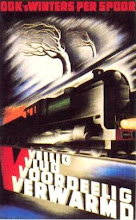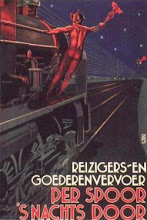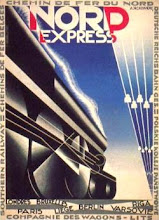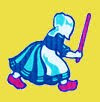Last week on the model train swap meeting in Houten, I acquired an old electrical engine made by the Bing Brothers in the roaring twenties, so now roughly 90 years old. It just mentions 18 V on the side, has a body that is brown lithographed with yellow stripes. It was more difficult than expected to find some information on this little engine on Internet, presumably because the name interferes with a now semi-popular search engine. Additionally, Bing apparently did not number its products like Märklin or Lionel did.
Nevertheless, I found two hits on the web, one in historytoy and one in German image gallery of stuff that once was on Ebay. On Historytoy it is named "Elektrolok 22". When I compare the pictures with the engine that I obtained, I notice that some previous owner has replaced the third rail pick-up assembly, but that for the rest the engine is complete; all the buffers, pantographs, box journals, etc. are there.
The engine did not run properly, tough; it created a lot of noise, vibrations and ozone. So, it was time for thorough inspection. The engine disassembles easily with the two screws and nuts that fastens the body to the black chassis. Then the black chassis can be removed from the central motor block with again two screws and nuts. I removed the red spoke wheels with a wheel puller and then the engine could be completely dissembled in its components.
On the photo above it is from left to right, the wire to front-light, the connectors for passenger cars lights, the top motor-block piece, the E-unit (reversing unit, in Bing terms the Fahrrichtungsumschalter), the stator coil, the bottom motor piece and the third rail assembly. I reckoned that nobody every opened this motor in 90 years time and that I had to remove the lot of hardened lubricant, carbon black and dust.
The E-unit drum was filthy and did not easily rotate, so I cleaned it with a Dremel tool with a brass wire brush and the lubricated the E-unit-axle.
I noticed that the wires were still cotton insulated and crumbly, so I removed them all and soldered new wires on. Furthermore, I found a short in the wire from the third rail pick-up to the stator coil. It missed its insulation at the position were it ran through the bottom of the bottom-motor-block.
So, that was an easy fix as well. Then I cleaned years of carbon dirt from the 3 pole commutator. I measured the stator coil: 3 Ohm. That is reasonably for an old coil. Then I measured the resistance between the 3 commutator plates: all 2.6 - 2.7 Ohm, so also reasonable. I reassembled the engine and with some wiggling it started to run fast. It is a fast spinner for a 90 year old electrical engine. So, now it is time to clean the large gear wheels and the red spoke wheels. Then I better repaint them bright red.
Above the front side of the cleaned engine with left the E-unit and right the green stator coil.
The back side, shows a bit of the E-unit on the right side. It is a electro-mechanical system, A hooked lever is moved by the stator coil and hooks in a gear with 4 teeth. Every time the current is engaged, the lever is pulled to the stator and the hooked lever rotates the E-unit drum for 90 degrees. Fairly smart stuff for the twenties.
Sunday, September 02, 2018
Sunday, February 18, 2018
Emsland modelling & toy train fair 2018
Last month, on 13 and 14th of January, the annual modelling & toy train fair was held in Lingen. I had been planning to visit them for several years. Last year there was too much snow and this year we could finally visit them. It is a swap meeting and exhibition of many trades of modelling. One hall was packaged with trains, one with trucks, the other with planes, boats, mini-steam engines and sterling motors. So it is a fairly broad happening in the Emslandhallen.
In a corner they flew with model air planes. But as usual in flight they are too fast to take a snap shot.
With RC trucks, it was apparently a custom to hire a dumpster filled with dirt and to let the off-road trucks run through it. We saw three of these dirt containers.
The collection of modelled boats was impressive. Most of them were RC boats that sailed in temporary pond at great speeds
My personal favorite was an Märklin scale zero layout. The rattling noise and the ozone smell were gorgeous.
In the swap meeting hall there were many sale booths with trains, most h0 and N. You had to look pretty good to find some scale zero stuff, like a Fleischmann train, a bunch of Lima railroad cars and one MTH boxcar. But the 45 € price tag for one box car without box was a bit too steep for me. I liked the many sales booths with electronic components, these were very handy.
The bread buns with salami, curry sausages with mustard were excellent. We just did not grasp the ice cream booth which had a healthy turnover. It ain't summer yet! Luckily the had plenty of beer to observe it all and to enjoy it all.
In a corner they flew with model air planes. But as usual in flight they are too fast to take a snap shot.
With RC trucks, it was apparently a custom to hire a dumpster filled with dirt and to let the off-road trucks run through it. We saw three of these dirt containers.
The collection of modelled boats was impressive. Most of them were RC boats that sailed in temporary pond at great speeds
My personal favorite was an Märklin scale zero layout. The rattling noise and the ozone smell were gorgeous.
In the swap meeting hall there were many sale booths with trains, most h0 and N. You had to look pretty good to find some scale zero stuff, like a Fleischmann train, a bunch of Lima railroad cars and one MTH boxcar. But the 45 € price tag for one box car without box was a bit too steep for me. I liked the many sales booths with electronic components, these were very handy.
The bread buns with salami, curry sausages with mustard were excellent. We just did not grasp the ice cream booth which had a healthy turnover. It ain't summer yet! Luckily the had plenty of beer to observe it all and to enjoy it all.
Sunday, January 28, 2018
Train world Brussels
A few weeks ago, we finally visited Train world in Brussels. We had planned to visit the Belgian railroad museum already for a few years, but due to the daily stuff, this has been postponed for too long. Nevertheless on a bleak winters day, we went to Schaerbeek railway station. I remember this station from my early childhood as the railroad station from which the sleeping trains to Biarritz left as the start of the summer holiday.
The entrance now is the side-hall of the original railway station. The original grandeur of the Victorian era can still be witnessed here, with the marble stone plating of the floor and walls. The personnel is friendly and for a relative small entrance fee you have access to a beautiful train museum. Via the restaurant (RN express) and the ticket tourniquets you walk in the large hall of the original train station Schaerbeek. There are several beautiful large scale models of old Belgian steamers. In the old wooden ticket booths there is a display of railroad uniforms, tickets and ticket vending machines. Next, you will exit the station at the back and you will see a remarkable large steam-powered railroad crane for accident recovery etc. It is an impressive large machine from deep in the nineteenth century, loving named Juliette.
After a small stroll you will enter a new building that looks remarkably much as a metal box. Again you will have to scan your tickets and then you enter the real large museum building. It is composed of four different huge halls which are packed with trains.
The first hall is very dark and contains five early steam engines, including the Pays du Waes. A small original steam engine from 1844 (so not reconstructed, but the real engine from 1844).
The engines are magnificent, however, due to the darkness in the hall, they are not so easy to photograph. Which is another good reason to purchase the museum catalog. We spend a good hour in this first hall, just to appreciate these old and occasionally quirky engines, but then they were engineered in the UK, so what else could one expect.
The third hall is filled with old coaches and in a corner they pilled up the remains of a modern vehicle which recently crossed the tracks when a train passed and shattered it. Although the airbags must have blown, the driver did not stand a single chance; a pile as mortal reminder.
The fourth hall contains some classic Belgian diesel and electric engines, post coach and a luxurious TEE coach from the seventies. A beautiful refreshments car sells beverages from a forgotten time.
Then you will walk the metal stairs (or take the elevator) to the attic where some old goods cars are placed under the roof.
A long walkway with models of bridges and fly-overs, a large model train display, the noses of the Eurotrain and Italo will bring you to the Belge. This is beautiful steam engine that flies over the museum shop.
So, all in all, it is an impressive train museum. In my humble opinion a must-see for train-lovers. Since there is much to see, a true enthusiast can easily spend a full day here. And since the restaurant is placed outside the museum, it is wise to eat before you enter, otherwise you have to negotiate your way out and in with the help of the museum shop personnel.
The entrance now is the side-hall of the original railway station. The original grandeur of the Victorian era can still be witnessed here, with the marble stone plating of the floor and walls. The personnel is friendly and for a relative small entrance fee you have access to a beautiful train museum. Via the restaurant (RN express) and the ticket tourniquets you walk in the large hall of the original train station Schaerbeek. There are several beautiful large scale models of old Belgian steamers. In the old wooden ticket booths there is a display of railroad uniforms, tickets and ticket vending machines. Next, you will exit the station at the back and you will see a remarkable large steam-powered railroad crane for accident recovery etc. It is an impressive large machine from deep in the nineteenth century, loving named Juliette.
After a small stroll you will enter a new building that looks remarkably much as a metal box. Again you will have to scan your tickets and then you enter the real large museum building. It is composed of four different huge halls which are packed with trains.
The first hall is very dark and contains five early steam engines, including the Pays du Waes. A small original steam engine from 1844 (so not reconstructed, but the real engine from 1844).
The engines are magnificent, however, due to the darkness in the hall, they are not so easy to photograph. Which is another good reason to purchase the museum catalog. We spend a good hour in this first hall, just to appreciate these old and occasionally quirky engines, but then they were engineered in the UK, so what else could one expect.
The second hall is filled with the jewel of Belgian railroading; the 12-series. A record keeping Atlantic stream-lined steamer from the thirties. Although a small rail motor and beautiful preserved coaches are also present in this hall, you will not notice them, because it is the 12004 engine that stands in the middle. The driving wheels are simply huge and the engine itself is remarkably high.
The fourth hall contains some classic Belgian diesel and electric engines, post coach and a luxurious TEE coach from the seventies. A beautiful refreshments car sells beverages from a forgotten time.
Then you will walk the metal stairs (or take the elevator) to the attic where some old goods cars are placed under the roof.
A long walkway with models of bridges and fly-overs, a large model train display, the noses of the Eurotrain and Italo will bring you to the Belge. This is beautiful steam engine that flies over the museum shop.
So, all in all, it is an impressive train museum. In my humble opinion a must-see for train-lovers. Since there is much to see, a true enthusiast can easily spend a full day here. And since the restaurant is placed outside the museum, it is wise to eat before you enter, otherwise you have to negotiate your way out and in with the help of the museum shop personnel.
Subscribe to:
Posts (Atom)






























